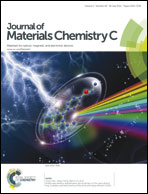Ultrafast chemical dynamic behavior in highly epitaxial LaBaCo2O5+δ thin films
Abstract
The redox reactions of highly epitaxial LaBaCo2O5+δ (LBCO) thin films exposed to the switching flow of reducing (H2) and oxidizing (O2) gases were examined at various temperatures between 260 and 700 °C. Their electrical resistance was measured using a precise ac bridge measurement system. The as-grown LBCO films have very good electrical conductivity at low and medium temperatures between 400 and 700 °C, and are extremely sensitive to reducing and oxidizing environments with superfast redox dynamics. The LBCO thin films show more complex redox reactions at low temperatures (300–350 °C), suggesting the occurrence of conducting-to-insulating-to-conducting transitions during the redox reactions. In particular, the insulating-to-conducting transition under an oxidation process is superfast, with the largest resistance change of up to 3 × 107 Ω s−1, occurring even at a low temperature of 300 °C. The extremely short response time, the giant resistance change, and the excellent chemical stability in a broad temperature range from 260 to 700 °C suggests that the highly epitaxial LBCO thin-films can be excellent candidates for low-temperature solid oxide fuel cells, chemical sensors, and catalyst applications.


 Please wait while we load your content...
Please wait while we load your content...